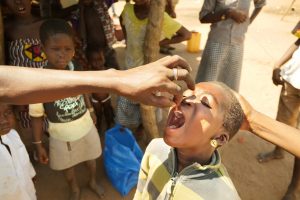With a special focus on women and children
By Amber Persson
Vitamin A Deficiency (VAD), the main cause of mortality in children living in areas that are considered at-risk, affects 20-25% of children in Niger. Vitamin A must be acquired through diet and plays a pivotal role in the immune system and visual system. Vitamin A Deficiency can cause stunting of growth, anemia, blindness, and death in extreme cases.
While serious, VAD is entirely preventable. Since December 1998, organizations studying the impact of VAD (UNICEF Regional Office for West and Central Africa and Helen Keller International) reported that vitamin A supplementation (VAS) in young children reduces their risk of premature death by 23%. An important component in fighting VAD is distributing Vitamin A supplements in capsules or fortifying the micronutrient in common food sources. Capsules have been distributed by organizations like Helen Keller International every 4-6 months in alliance with WHO guidelines.

Source: Ruth Fertig; Helen Keller International
The situation requires more than capsules, however, as that is a temporary solution. The best way to consistently increase Vitamin A uptake is through animal and plant products. Dairy products in particular are rich in many vitamins but are expensive and hard to come by in Niger. Vitamin A rich plant products such as carrots (which only 5% of Nigerien children eat) are difficult to access in a country that usually has only one harvest per year. In Niger, fortifying the micronutrient in common products like cooking oil helps Nigeriens gain access to it year-round.
There has been an increased effort to combat VAD in women of childbearing age and lactating mothers along with children in the past few years. Children obtain their nutrients from their mothers while in the womb and while breastfeeding. A malnourished mother can lead to a malnourished infant. Mothers also require extra nutrients and calories while pregnant to accommodate their growing child. Increasing a mother’s vitamin A intake will not only benefit her child but will also prevent certain maternal complications during birth.
VAD is just as prevalent today as it was in 1998, but VAS is an affordable solution for improving maternal, child, and community health. When battling malnutrition, nutrient supplementation and access to clean water go hand in hand. Every time that a well is drilled, the villagers are trained in the use of greywater and drip irrigation. This allows the community to supplement their diets with vitamin-rich fresh foods that help to fight the epidemic of VAD.
Sources:
Maintaining High Vitamin Supplementation Coverage in Children Lessons from Niger:
https://journals.sagepub.com/doi/pdf/10.1177/156482650502600103
Intrahousehold management and use of nutritional supplements during the hunger gap in Maradi region, Niger: a qualitative study
https://bmcnutr.biomedcentral.com/articles/10.1186/s40795-019-0329-0
Helen Keller International and VAS
https://www.givewell.org/charities/helen-keller-international#What_do_they_do
Vitamin A Supplementation handbook
https://www.givewell.org/international/technical/programs/vitamin-A
Importance of provitamin sources in Africa
https://journals.sagepub.com/doi/pdf/10.1177/156482650102200403


